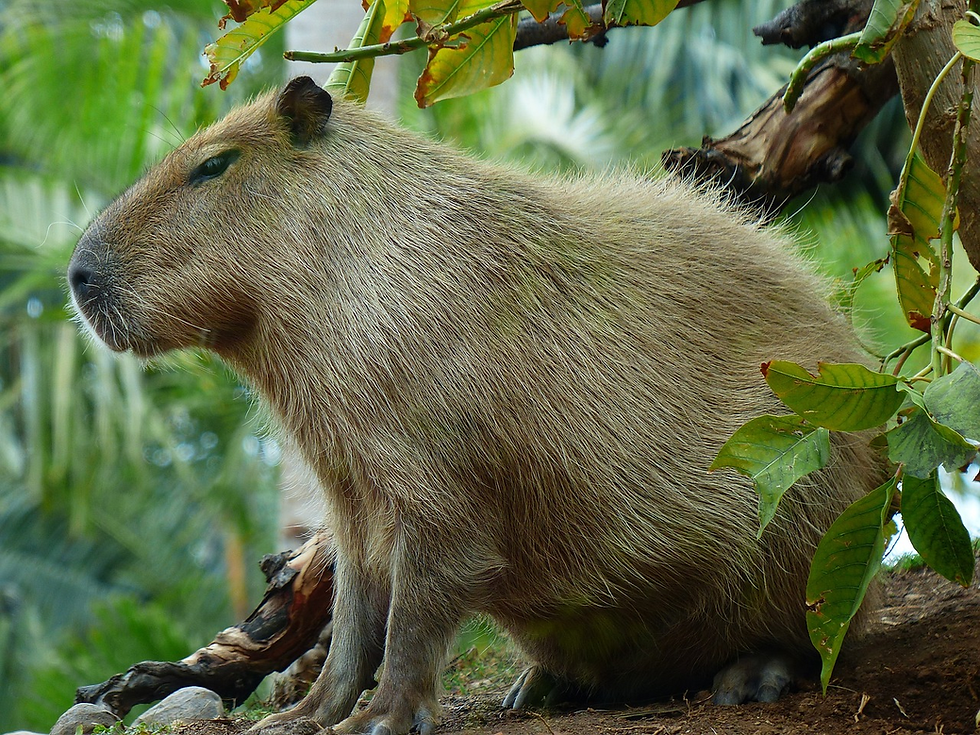What Is a Capybara? Exploring the Fascinating World of Nature's Largest Rodent
- Colton Cowie
- May 27, 2023
- 3 min read
Updated: Jul 7, 2024
When it comes to the animal kingdom, we often encounter unique and captivating creatures that spark our curiosity. One such creature is the capybara, a remarkable rodent that holds the title of being the largest in the world. In this article, we will delve into the world of capybaras, exploring their physical characteristics, habitat, behavior, and their role in ecosystems. So, let's embark on an exciting journey to discover what makes capybaras such fascinating and endearing animals.

The Basics: What Are Capybaras?
To understand capybaras better, let's start with the basics. Capybaras (Hydrochoerus hydrochaeris) are semi-aquatic mammals native to South America, specifically found in regions such as the Amazon rainforest, the Pantanal wetlands, and the savannas of Argentina. These extraordinary creatures belong to the family Caviidae and the order Rodentia, which includes other familiar rodents like mice, rats, and squirrels.
Size and Physical Characteristics
Capybaras are renowned for their impressive size. On average, they measure around 1 to 1.3 meters (3.3 to 4.3 feet) in length and stand about 0.5 meters (1.6 feet) tall at the shoulder. Adult capybaras can weigh anywhere from 35 to 65 kilograms (77 to 143 pounds), with some individuals reaching even higher weights. Their large, barrel-shaped bodies are covered in short, coarse fur, which can range in color from reddish-brown to dark brown or grayish-brown.

Adaptations for an Aquatic Lifestyle
One of the most intriguing aspects of capybaras is their semi-aquatic nature. They have several adaptations that enable them to thrive in aquatic environments. Capybaras possess webbed feet, which facilitate swimming and make them excellent divers. Their eyes, ears, and nostrils are strategically positioned on the top of their heads, allowing them to stay submerged in water while keeping a watchful eye on their surroundings. Their partially webbed hind feet and long, slender limbs also aid in efficient movement through water.
Habitat and Distribution
Capybaras are mainly found in South America, inhabiting a range of environments from lush rainforests to grassy marshlands. They are particularly prevalent in countries such as Brazil, Venezuela, Colombia, Paraguay, and Argentina. These adaptable creatures are highly versatile when it comes to their habitat choices and can be found near rivers, lakes, swamps, and even man-made water bodies such as reservoirs or ponds.
Social Behavior and Communication
Capybaras are highly social animals, often forming large groups called herds or "capybara communities." These communities typically consist of around 10 to 30 individuals but can sometimes include as many as 100 members. Living in such groups helps them maintain a strong defense against predators and ensures efficient communication within the herd. Capybaras communicate through a variety of vocalizations, body postures, scent marking, and tactile interactions.
Diet and Feeding Habits
Capybaras are herbivores, feeding primarily on vegetation such as grasses, aquatic plants, and tree bark. Their digestive system is adapted to process large quantities of plant matter efficiently. Capybaras have a unique habit called coprophagy, where they consume their own feces. This process allows them to extract essential nutrients that were not fully absorbed during the initial digestion, maximizing their nutritional intake.
Ecological Importance
Capybaras play a significant role in their ecosystems. As herbivores, they contribute to the dispersion of seeds, helping in the regeneration and distribution of plant species. They also act as a food source for predators like jaguars, crocodiles, anacondas, and birds of prey, maintaining a delicate balance in the food chain. Additionally, capybaras create pathways in vegetation while foraging, benefiting smaller animals by providing access to resources.

Conservation Status and Threats
While capybaras are not currently considered endangered, they do face certain threats to their population. Habitat loss due to deforestation, hunting for their meat, and competition for resources with livestock are some of the challenges capybaras encounter. Conservation efforts are essential to ensure the long-term survival of these remarkable creatures and their habitats.
Conclusion
The capybara's unique blend of size, social behavior, adaptability, and ecological significance makes it a fascinating subject of study and admiration. As nature's largest rodent, the capybara's presence in South American ecosystems has a profound impact. Understanding and appreciating these remarkable creatures can not only enhance our knowledge of the natural world but also inspire us to protect and preserve the diversity of life on our planet. So, the next time you come across a capybara, take a moment to marvel at its remarkable adaptations and the vital role it plays in its environment.
Comments